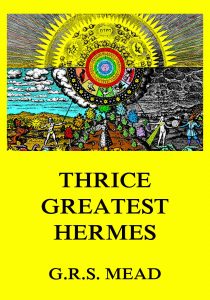Thrice-Greatest Hermes – G. R. S. Mead
This is the edition including all three books. The so-called Hermetic writings have been known to Christian writers for many centuries. The early church Fathers (Justin Martyr, Tertullian, Clement of Alexandria) quote them in defense of Christianity. Stobaeus collected fragments of them. The Humanists knew and valued them. They were studied in the sixteenth and seventeenth centuries, and in modern times have again been diligently examined by many scholars. G. R. S. Mead has issued a translation of the whole body of extant literature, with extended prolegomena, commentary, etc. There is a wide difference of opinion as to the date at which this literature was produced. Mead believes that some of the extant portions of it are at least as early as the earliest Christian writings, while von Christ assigns them to the third Christian century, and thinks that they show the influence of neo-Platonism. To affirm that they influenced New Testament usage would be hazardous, but they perhaps throw some light on the direction in which thought was moving in New Testament times.
Format: Paperback.
Thrice-Greatest Hermes.
ISBN: 9783849674816.
Available at amazon.com and other venues.
G. R. S. Mead and the Theosophical Society (from wikipedia.com)
While still at Cambridge University Mead read Esoteric Buddhism (1883) by Alfred Percy Sinnett. This comprehensive theosophical account of the Eastern religion prompted Mead to contact two theosophists in London named Bertam Keightly and Mohini Chatterji, which eventually led him to join Helena Petrovna Blavatsky’s Theosophical Society in 1884.
In 1889 he abandoned his teaching profession to become Blavatsky’s private secretary, and also became a joint-secretary of the Esoteric Section (E.S.) of the Theosophical Society, reserved for those deemed more advanced.
Mead received Blavatsky’s Six Esoteric Instructions and other teachings at 22 meetings headed by Blavatsky which were only attended by the Inner Group of the Theosophical Society. It was because of the intimacy Mead felt with the Inner Group that he married Laura Cooper in 1899.
Contributing intellectually to the Theosophical Society, at first most interested in Eastern religions, he quickly became more and more attracted to Western esotericism in religion and philosophy, particularly Neoplatonism, Gnosticism, and Hermeticism, although his scholarship and publications continued to engage with Eastern religion. Making many contributions to the Theosophical Society’s Lucifer as joint editor, he eventually became the sole editor of The Theosophical Review in 1907 (as Lucifer was renamed in 1897).
As of February 1909 Mead and some 700 members of the Theosophical Society’s British Section resigned in protest at Annie Besant’s reinstatement of Charles Webster Leadbeater to membership in the society. Leadbeater had been a prominent member of the Theosophical Society until he was accused in 1906 of teaching masturbation to the sons of some American Theosophists under the guise of occult training. While this prompted Mead’s resignation, his frustration at the dogmatism of the Theosophical Society may also have been a major contributor to his break after 25 years.
(The text of the last section was taken from a Wikipedia entry and is available under the the Creative Commons Attribution-ShareAlike License.)
Publisher’s Note: This book is printed and distributed by Createspace a DBA of On-Demand Publishing LLC and is typically not available anywhere else than in stores owned and operated by Amazon or Createspace.

